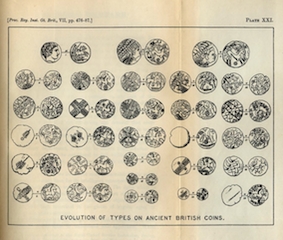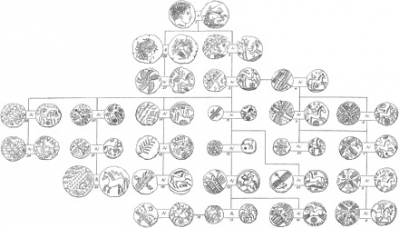To search the RPR site click here
Did Pitt-Rivers 'imitate' Evans' work?
Many of Pitt-Rivers' publications from the 1860s until 1891 (at least) refer to John Evans' work on numismatics and specifically to Evans' illustrations of the way imagery and inscriptions on coins degraded as coins were copied. In essence Evans (and Pitt-Rivers) saw this degradation as a form of the old-fashioned children's game, Chinese whispers, in which a message is passed round a group of people by whispers, and by the end is unrecognizable.
Schlanger points out that:
... the General was unique in perceiving the exemplary potential of Evans’s serial numismatics for ethnology and prehistoric archaeology. Already in his 1868 programmatic paper, Pitt Rivers had proclaimed that human progress did not result from ex nihilo individual invention but rather from continuous imitation and variation through such agencies as “unconscious selection” and “errors in successive copies”. As a prime example of this latter process, continued Pitt Rivers, “Mr. Evans has shown in his work on the ‘Coins of the Ancient Britons’ (p. 167) how the head of Medusa, copied originally from a Greek coin, was made to pass through a series of apparently meaningless hieroglyphics, in which the original head was quite lost, and was ultimately converted into a chariot and four”.In fact this numismatic transformation became for Pitt Rivers a canonical example that he expanded and applied throughout his subsequent publications. [Schlanger, 2010: 358 quoting Lane Fox, Primitive Warfare II (1868) page 97)
According to Schlanger, Pitt-Rivers 'specifically sought permission to include one of Evan's numismatic diagrams in his own publications, otherwise essentially illustrated with plates of his own making'. This borrowed plate 'is said to be reproduced, with permission, from Evans, "Coinage of Ancient Britons"', though it is clearly not the other illustration taken from that work given here. [2010: 358, 369] This is the illustration shown as Plate VII or XXI of 'On the Evolution of Culture', as published in 1906 in his collected essays, and is titled 'Evolution of types on ancient British coins'. However, the plate does not appear to be discussed within the text of 'On the Evolution of Culture' after which it is bound, it is unclear why it is given as a plate in this collected work of Pitt-Rivers' essays. Pitt-Rivers' diagram from the 1906 edition is shown as the first illustration on this page.
Evans' diagram, shown here, sets out the evolution of British Iron Age coin types from the stater of Philip II of Macedon and was given in the Numismatic Chronicle 12 (1850), p. 127. Evans in his paper hoped to 'show how, from this prototype [the stater], by means of successive imitations of imitations, a number of new and totally distinct types arose, until their original was quite lost sight of'. Like Pitt-Rivers he expected readers to see or 'trace' these changes from coin to coin in a series of transitions, or as Pitt-Rivers would call it, degradations. As Schlanger points out, Evans' terminology in this paper uses analogies with biological processes like 'descent', 'varieties', 'derivations' and 'pedigrees'. (2010: 346) Like Pitt-Rivers he was using natural science (or evolution) to inform in another discipline's debates.
Pitt-Rivers then discussed Evans' work in 1872 at the meeting of the British Association for the Advancement of Science, (see here for further information):
... No one who had not by previous experience been impressed with the continuity pervading all savage ornamentation would dream of connecting two such widely different forms as those represented in these two figures. Those, however, who are familiar with the pictographic changes which marked the origin of the Phoenician and Scandinavian alphabets, or who have studied Mr Evans's work on Ancient British Coins, or the researches of Mr Edward Thomas into the Coins of India, will be prepared for the marvellous transformations to which human and other forms are subjected when they are copied and recopied by the inaccurate and uninstructed eyes of savage imitators. They will remember how the chariot and horses on the Greek coins of Philip of Macedon, in the hands of the Gaulish and British artists, gradually lost, first the body of the chariot, then the body of the charioteer - how the wheels of the chariot became mixed up with the body of the horse, and the head of the driver appeared floating like a cherubim over the horse's ears - and how, on the obverse of the coin, the nose and features of the head gradually disappeared, until nothing but the wreath converted into a cruciform ornament remained to connect it with the original figure of the Greek king. … [Taken from Colonel Augustus Lane Fox’s address to the Anthropological Department of the British Association for the Advancement of Science meeting in Brighton, 1872]
Lane Fox next discussed this diagram at his talk about the principles of classification in 1874, discussed here:
In the transformations of this latter ornament, which I took occasion to bring to the notice of the meeting of the Anthropological Department of the British Association at Brighton, and which are represented in the annexed plate (xxii), we see a remarkable example of degradation of form produced by gradual changes caused by these people in copying from one another until the original design is lost. The representation of a human figure is here seen to lose gradually its limbs and body, then the sides of the face, leaving only the nose and ears, and ultimately the nose only, which finally expands at the base, and is converted into the representation of a half moon. In this sequence we have an exact parallel to the transformations observed upon ancient British coins by Mr. Evans, by which a coin of Philip of Macedon, representing a chariot and horses, becomes converted by a succession of similar changes into the representation of a single horse, and ultimately into fragments of a horse.
Given the early date of Evans's publication, it can be clearly shown to predate Pitt-Rivers' own interest in the development of series and degeneration of form.
Bibliography for this article
Evans, John “On the date of British coins”, Numismatic chronicle, xii (1850), pp. 127–37.
Fox, A.H. Lane 1872 ‘Address to the Department of Anthropology of the British Association at Brighton.’ Report: British Association for the Advancement of Science [1872] pp. 157-174
Pitt-Rivers, A.H.L.F. 1906 [ed. JL Myers, intro by Henry Balfour] The Evolution of Culture and other essays Clarendon Press Oxford UK
Schlanger, Nathan. 2010. Series in Progress: Antiquities of Nature, Numismatics and Stone Implements in the Emergence of Prehistoric Archaeology History of Science vol 48 parts 3/4 No 161 September/ December pp. 343–369
AP, February 2011





